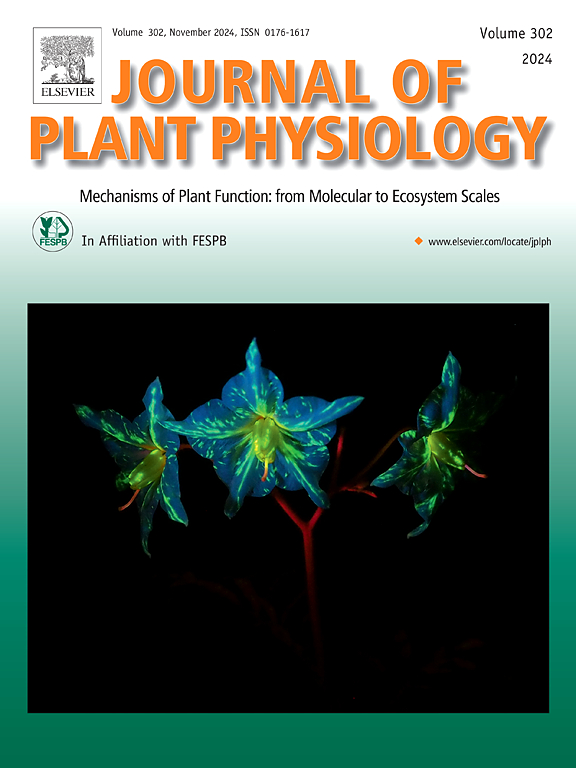Osmotic stress-induced CsRCI2E endosomal trafficking modulates CsPIP2 aquaporins at the plasma membrane in Camelina sativa
IF 4.1
3区 生物学
Q1 PLANT SCIENCES
引用次数: 0
Abstract
Rare Cold Inducible 2s (RCI2s) are membrane-associated proteolipids dynamically trafficking between the plasma membrane (PM) and the endomembrane system. Their expression is upregulated in response to abiotic stresses, including cold, heat, drought, and salinity, contributing to plant stress tolerance. CsRCI2E interacts with the water transport protein CsPIP2; 1, reducing its abundance at the PM under NaCl-induced stress. Consequently, CsRCI2E is considered a potential regulator of CsPIP2 endocytosis involved in maintaining cellular homeostasis. However, its precise role in membrane trafficking remains unclear. Therefore, this study aims to investigate the rapid internalization of CsRCI2E and CsPIP2 under mannitol-induced and NaCl-induced osmotic stress using a sucrose density gradient. CsRCI2E transcription levels increased significantly 3 h posttreatment with mannitol or NaCl. CsRCI2E overexpression enhanced stress tolerance and reduced reactive oxygen species accumulation-induced cellular damage during Camelina germination. Despite no concurrent change in CsRCI2E gene expression, the subcellular distribution of CsRCI2E and CsPIP2s (CsPIP2; 1 and CsPIP2; 2) shifted rapidly from the PM to the endomembrane within 0.5 h following osmotic stress. Additionally, CsRCI2E overexpression induced internalization and subcellular redistribution of CsRCI2E and CsPIP2s under osmotic stress and non-stress conditions. These findings suggest that CsRCI2E internalization functions as a sensing mechanism during the initial phase of osmotic shocks. Furthermore, elevated CsRCI2E levels promote CsPIP2s membrane trafficking from the PM to the endomembrane system, supporting water homeostasis in Camelina.
渗透胁迫诱导的cspci2e内体运输调节Camelina sativa质膜上的CsPIP2水通道蛋白
稀有冷诱导2s (RCI2s)是在质膜和膜内系统之间动态运输的膜相关蛋白脂类。它们的表达在冷、热、干旱和盐度等非生物胁迫下上调,有助于植物的抗逆性。CsRCI2E与水转运蛋白CsPIP2相互作用;1、在nacl胁迫下降低其在PM处的丰度。因此,CsRCI2E被认为是参与维持细胞稳态的CsPIP2内吞作用的潜在调节剂。然而,其在膜运输中的确切作用尚不清楚。因此,本研究旨在利用蔗糖密度梯度研究甘露醇诱导和nacl诱导的渗透胁迫下CsRCI2E和CsPIP2的快速内化。甘露醇或NaCl处理后3 h, CsRCI2E转录水平显著升高。CsRCI2E过表达增强了亚麻荠萌发过程中的胁迫耐受性,减少了活性氧积累引起的细胞损伤。尽管CsRCI2E基因表达没有同步变化,但在渗透胁迫后0.5 h内,CsRCI2E和CsPIP2s (CsPIP2; 1和CsPIP2; 2)的亚细胞分布迅速从PM转移到膜内。此外,在渗透胁迫和非胁迫条件下,CsRCI2E过表达诱导CsRCI2E和CsPIP2s的内化和亚细胞重分布。这些发现表明,CsRCI2E内化在渗透冲击的初始阶段作为一种感知机制发挥作用。此外,升高的CsRCI2E水平促进CsPIP2s从PM到膜内系统的膜运输,支持茶树的水稳态。
本文章由计算机程序翻译,如有差异,请以英文原文为准。
求助全文
约1分钟内获得全文
求助全文
来源期刊

Journal of plant physiology
生物-植物科学
CiteScore
7.20
自引率
4.70%
发文量
196
审稿时长
32 days
期刊介绍:
The Journal of Plant Physiology is a broad-spectrum journal that welcomes high-quality submissions in all major areas of plant physiology, including plant biochemistry, functional biotechnology, computational and synthetic plant biology, growth and development, photosynthesis and respiration, transport and translocation, plant-microbe interactions, biotic and abiotic stress. Studies are welcome at all levels of integration ranging from molecules and cells to organisms and their environments and are expected to use state-of-the-art methodologies. Pure gene expression studies are not within the focus of our journal. To be considered for publication, papers must significantly contribute to the mechanistic understanding of physiological processes, and not be merely descriptive, or confirmatory of previous results. We encourage the submission of papers that explore the physiology of non-model as well as accepted model species and those that bridge basic and applied research. For instance, studies on agricultural plants that show new physiological mechanisms to improve agricultural efficiency are welcome. Studies performed under uncontrolled situations (e.g. field conditions) not providing mechanistic insight will not be considered for publication.
The Journal of Plant Physiology publishes several types of articles: Original Research Articles, Reviews, Perspectives Articles, and Short Communications. Reviews and Perspectives will be solicited by the Editors; unsolicited reviews are also welcome but only from authors with a strong track record in the field of the review. Original research papers comprise the majority of published contributions.
 求助内容:
求助内容: 应助结果提醒方式:
应助结果提醒方式:


